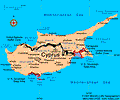Cyprus
Facts & Figures

-
President: Nikos Anastasiadis (2013)
Land area: 3,568 sq mi (9,241 sq km); total area: 3,571 sq mi
Population (2014 est.): 1,172,458 (growth rate: 1.48%); birth rate: 11.44/1000; infant mortality rate: 8.54/1000; life expectancy: 78.34
Capital and largest city (2011 est.): Necosia 253,000
Monetary unit: Euro
National name: Kypriaki Dimokratia—Kibris Cumhuriyeti
Languages: Greek, Turkish (both official); English
Ethnicity/race: Greek 77%, Turkish 18% (each concentrated almost exclusively in separate areas); other 5% (2001)
National Holiday: Independence Day, October 1
Religions: Greek Orthodox 78%, Islam 18%, Maronite, other (includes Maronite and Armenian Apostolic) 4%
Literacy rate: 98.7% (2011 est.)
Economic summary: GDP/PPP: $21.62 billion (2013 est.); $24,500 per capita (2013 est.). Real growth rate: –8.70%. Inflation: 0.2% (2013 est.). Unemployment: 17.4%. Arable land: 9.06%. Agriculture: citrus, vegetables, barley, grapes, olives, vegetables; poultry, pork, lamb; dairy, cheese. Labor force: 443,500 (2013); agriculture, 8.5%; industry, 20.5%; services, 71% (2006). Industries: tourism, food and beverage processing, cement and gypsum production, ship repair and refurbishment, textiles, light chemicals, metal products, wood, paper, stone, and clay products. Natural resources: copper, pyrites, asbestos, gypsum, timber, salt, marble, clay earth pigment. Exports: $2.42 billion (2013 est.). Imports: $4.747 billion (2013 est.). Major trading partners: UK, Greece, Germany, France, Italy, Israel, Netherlands, China (2006).
Member of Commonwealth of Nations
Communications: Telephones: main lines in use: 373,200 (2012). Mobile cellular: 1.11 million (2012). Broadcast media: mixture of state and privately run TV and radio services; the public broadcaster operates 2 TV channels and 4 radio stations; 6 private TV broadcasters, satellite and cable TV services including telecasts from Greece and Turkey, and a number of private radio stations are available; in areas administered by Turkish Cypriots, there are 2 public TV stations, 4 public radio stations, and privately owned TV and radio broadcast stations (2007). Internet hosts: 252,013 (2012). Internet users: 433,900 (2009).
Transportation: Railways: 0 km. Highways: 20,006 km; paved: 8,564; unpaved: 4,442 km (2011); under government control: 13,006 km (includes 2,277 km of expressways); under Turkish Cypriot control: 7,000 km. Ports and harbors: area under government control: Larnaca, Limassol, Vasilikos; area administered by Turkish Cypriots: Famagusta, Kyrenia. Airports: 15 (2013).
International disputes: hostilities in 1974 divided the island into two de facto autonomous entities, the internationally recognized Cypriot Government and a Turkish-Cypriot community (north Cyprus); the 1,000-strong UN Peacekeeping Force in Cyprus (UNFICYP) has served in Cyprus since 1964 and maintains the buffer zone between north and south; on 1 May 2004, Cyprus entered the European Union still divided, with the EU's body of legislation and standards (acquis communitaire) suspended in the north; Turkey protests Cypriot Government creating hydrocarbon blocks and maritime boundary with Lebanon in March 2007.

